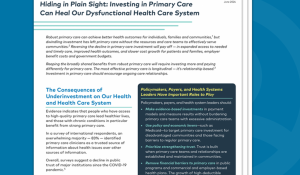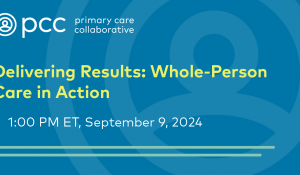The Patient Preferences Passport is a user-friendly tool patients can use to take ownership of their care. Additionally, the guide outlines how to effectively implement the tool in practice settings.
You are looking at an archived version of our site. Please visit thepcc.org for a fresh, new experience!
Making the Most of Visits
Related Resources
Ottobre 2015
This easy to use, interactive PDF contains a vision for patient and family engagement in health care, a set of 8 change strategies, tactics and milestones and simple actions to take today.
American Institute for Research, Gordon and Betty Moore Foundation
Ottobre 2017
Tool for patients to effectively record discussions, decisions made and follow up items from an appointment.
AHRQ
Ottobre 2019
Brochures and posters about Ask Me 3® -- an educational program that encourages patients and families to ask three specific questions of their providers to better understand their health conditions and what they need to do to stay healthy.
Institute for Healthcare Improvement
Ottobre 2017
The Be Prepared To Be Engaged toolkit will help patients and their families prepare for and become more fully engaged in their medical appointments—to be ready for the appointment, to speak up, to ask questions, to take notes. Tools are also available for clinicians and practice staff to...
AHRQ
Ottobre 2018
This guide outlines how practices can involve patient and family advisors in the Choosing Wisely implementation, which helps patients ask questions and make informed decisions.
Choosing Wisely, IPFCC, PCPCC
Ottobre 2014
This four minute video provides a overview of the Patient-Centered Medical Home, and how it can improve our healthcare system for both patients and providers.
Emmi
Ottobre 2019
These downloadable resources can be used by clinicians to educate patients about Choosing Wisely, which helps patients ask questions and make informed decisions. Several of these items can be placed in waiting or exam rooms or given to patients as handouts.
Choosing Wisely, ABIM Foundation
Ottobre 2019
This website includes over 100 health literary assessment tools. Numerous search filters are available, including specific context/disorder.
University of Boston, U.S. National Library of Medicine, CommunicateHealth, Inc.
Ottobre 2017
This webinar provides an overview of the Warm Handoff Strategy and how to implement it within primary care clinic settings.
AHRQ
Ottobre 2017
The Quick Start Guide provides clinicians and practice staff with five simple steps for implementing the warm handoff strategy in the office setting, and resources to encourage patient participation.
AHRQ
Settembre 2019
Patient portals are becoming more prevalent, as healthcare providers, payers, and patients become more comfortable with their use. A 2017 survey found that 82% of patients reported having logged into their provider’s patient portal at least once – a drastic change from a similar 2013...
Patient Portals: How can they impact primary care?
Ottobre 2018
This peer-reviewed report on health care transition for pediatric to adult health care includes a process for transition preparation, planning, tracking, and follow-through and is based on more than two decades of evidence-based research. A special focus is placed on young adults with special...
American Academy of Pediatrics
Aprile 2018
This document outlines how patient and family engagement activities can improve health outcomes and achieve TCPI program-specific metrics, which align with quality payment program standards. Links to additional resources for a deeper dive are also provided.
Northern New England Practice Transformation Network
Aprile 2018
This comprehensive guide provides primary care practices with four strategies that they can adopt to improve patient safety and engagement.
AHRQ
Aprile 2018
Five modules and links to a wide-range of resources for moving patients forward on the patient activation continuum. The tools are listed by category, and include Activation, Communication, Decision Aids, Self-Management and Shared-Decision Making.
Military Heath System
Marzo 2018
The Mayo Clinic Shared Decision Making National Resource Center provides decision aids and decision-making techniques. Tools are available for specific conditions and in English and Spanish.
Mayo Clinic
Marzo 2018
AHRQ’s SHARE Approach is a five-step process for shared decision-making. Fact sheets, learning modules, videos, success stories, webinars and marketing materials are available.
AHRQ
Marzo 2018
This site contains information for patients to prepare for radiation exams, therapies or procedures. There are over 230 procedure, exam and disease descriptions available.
Radiological Society of North America, Inc. (RSNA)
Marzo 2018
This learning module reviews common causes of medication nonadherence and how your practice can establish a standrd process to address them. 0.5 CME credits from the AMA are available upon completion.
American Medical Association, AMA Steps Forward
Pagine
Menu secondario
Copyright © 2024 Primary Care Collaborative












